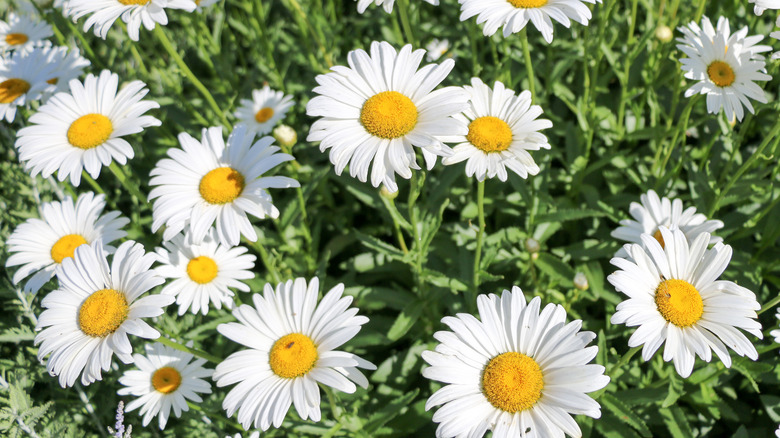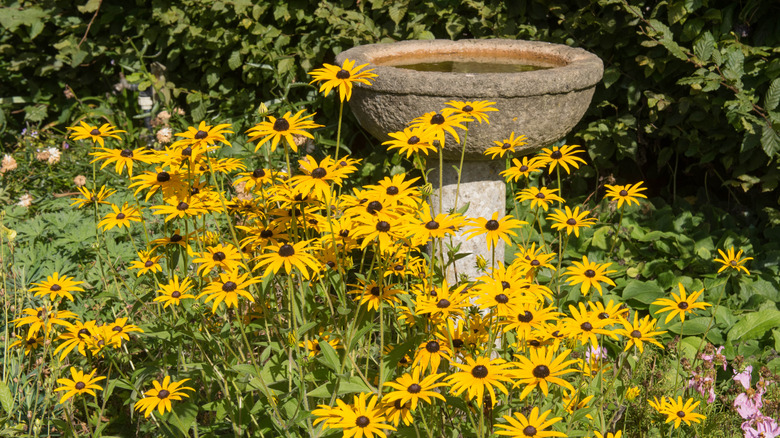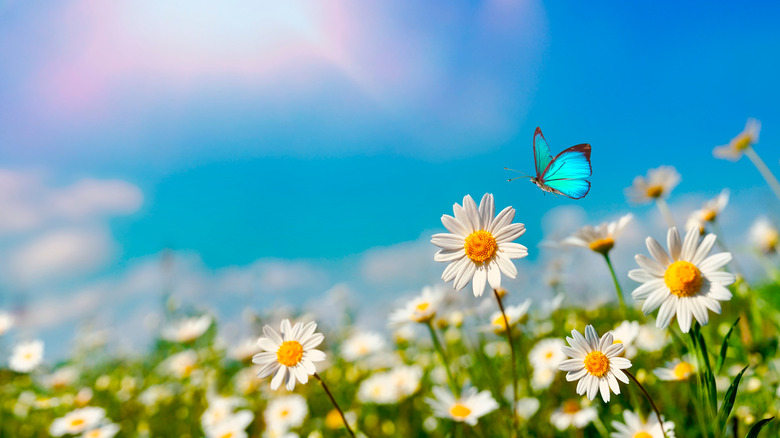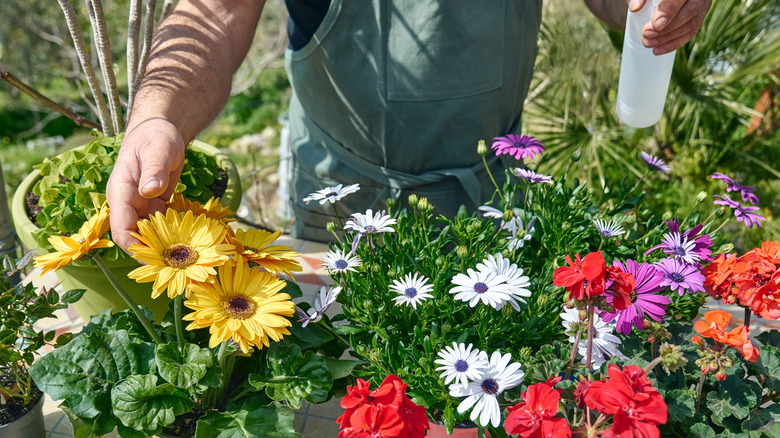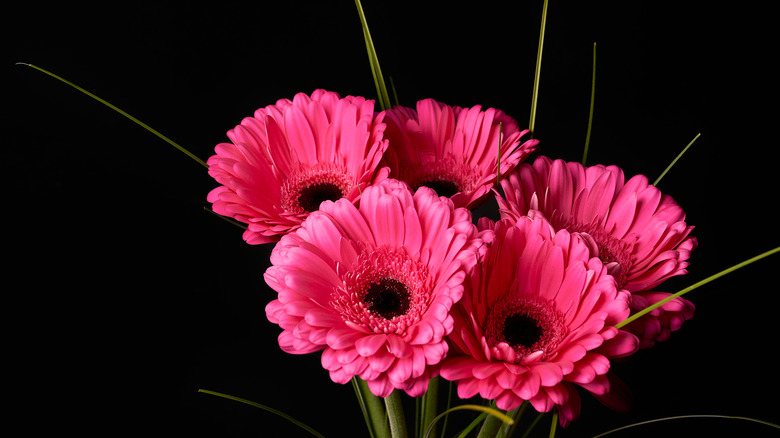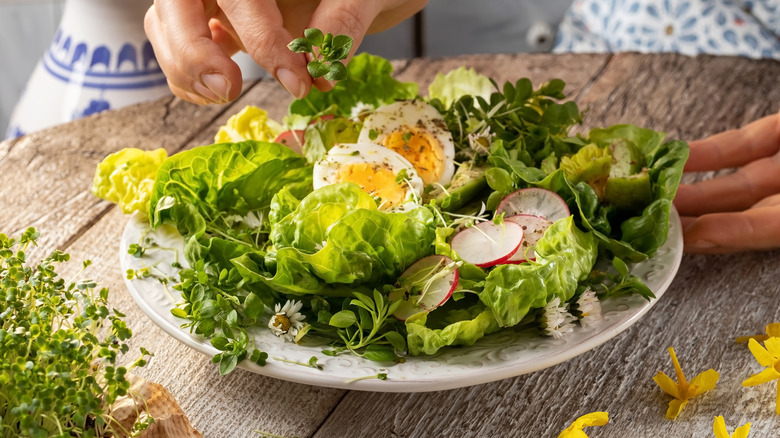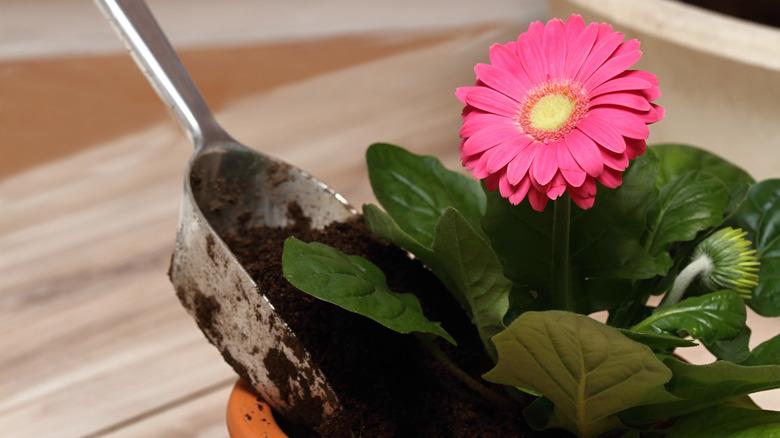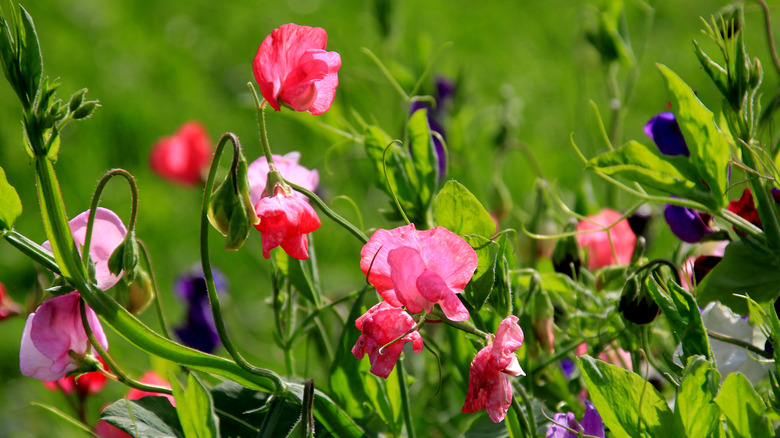How To Care For An April Birth Flower
A bouquet of daisies spreads joy and friendship instantaneously with their colorful, bursting petals. The daisy (Leucanthemum ssp.) is a darling flower, whether planted in gardens, as a border, or in window boxes. The flower is part of many species that stems from the extensive group of similar plants known as Asteraceae, or Compositae. This group includes some popular flowers, such as aster, chrysanthemum, sunflower, and zinnia, per The Spruce. Ancient as the Egyptians, people commonly used the daisy in gardens and for medicinal purposes.
Often a reminder of childhood innocence, happiness, and friendship, the daisy is a perennial herbaceous plant that comes in various colors like pink, purple, red, yellow, and white. The stem might grow a few inches to a few feet in height, depending on the type. Usually found around cottages, daisies are iconic flowers, effortless to grow and propagate. Besides being the predominant April birth flower, the daisy is a vigorous plant flourishing in almost any environment. With their stunning colors and appearances, they are exceptionally hardy, drought-resistant plants, providing enjoyment from the early summer months into the fall.
How to use an April birth flower in garden
The daisy is a popular choice among garden enthusiasts, including florists for bridal bouquets or other special events. Daisies also thrive amidst versatile landscaping. Places in the garden to consider are as a focal point, possibly surrounding a lawn ornament or birdbath. You might also place them along borderlines with other contrasting flowers. Create a wildflower haven by decorating your cottage garden with complementary flowering plants like hollyhock, larkspur, and sweet pea, per SF Gate. Whether you blend them or conceal other unwanted sights, your garden is sure to be filled with joy.
Some daisy cultivars are extremely dynamic and can grow like weeds (Shasta and Oxeye), per American Meadows. Make sure to place your seeds or plant sparingly, as they may madly flourish (if undesired). Wherever you decide to plant your daisy in the garden, the location should receive full sun. Although some varieties may tolerate partial shade, daisies are delighted with at least 6 hours of full sunshine in temperate climates. Plant them in rich, well-drained (never too wet) soil, preferably with organic compost.
How to grow an April birth flower
As cheerful as the sun, daisies love summertime. Although they may thrive in most regions, they're generally designated for plant hardiness zones 4 through 9. Additionally, depending on the type of the flower and whether it's annual or perennial, they may have different plant hardiness zones, so double check your location with the USDA Plant Hardiness Zone Map. While they can handle dry spells, don't let them overheat, so if it's too hot, move them to partial shade. The daisy likes soil that is neutral to slightly acidic but can bear most types if there is room to expand (6.0-8.0 pH scale, per Kellogg Garden). Many daisies are rhizomatic, meaning they grow and spread sideways underground, likely needing to be divided every few years.
If you're planting the April birth flower from seed, initiate the process indoors six to eight weeks before the last frost: Late autumn is an ideal time. Insert them ¼ inch deep in a starter tray, then transfer them outdoors when warm enough. Plant established nursery daisies in spring in a light, sunny spot by digging a hole as deep as the root balls and twice as wide and positioning them 12 inches apart. Place the plant in the hole, ensuring the top is even with the surface and water once a week, depending on the heat level, Gardening Channel recommends.
How to care for an April birth flower
A garden staple, the daisy is an April birth flower that is relatively low-maintenance. When it comes to watering, give it a drink at the base to avoid damaging its delicate petals. The plant won't grow properly if the soil is mushy, so make sure the soil is well-drained before watering again, Masterclass advises. Overall, the daisy should receive lots of sunlight without too much heat and a reasonable amount of water in well-draining soil.
If your daisies need a boost, you can apply an all-purpose organic fertilizer (10-10-10 ratio) in the spring to encourage steady growth; add more if needed throughout the growing season. Wait a couple of weeks after the initial planting, then fertilize each month if you prefer so. To conserve your plant's life, deadhead any wilted flowers and cut stems back to 2 inches above the ground during fall after the first frost, per Gardening Channel. This will endorse the growth of blooms and maintain their health. When pruning, you can pluck the withered stems as needed or sheer them back. Finally, you can prune your daises back to the baby buds emerging under the current blooms as it will boost the reproduction of the next generation.
Varieties of the April birth flower
Daisies are prevalent worldwide, found naturally in wild, grassy fields or grown from seed. With over 20,000 species, it may be hard to pick just one type, per Gardening Chores. There is a plethora of different colors and types of daisies, but here are six to consider:
- English Daisy (Bellis perennis) — Lovely yet invasive, low-growing plants, English daisies are typically grown as biennials in warm climates and annuals in cool ones, zones 4 through 8.
- Gerbera (Gerbera jamesonii) — Native to South Africa, this daisy type is a favorite for fresh-cut flowers with its dramatic display of colors. Gerbera is a gentle perennial, growing best in zones 8 through 10b.
- Marguerite (Argyranthemum frutescens) — A vibrant perennial, often found in pink, purple, yellow, and white hues, this plant thrives best during spring and fall when night temperatures get below 75 degrees.
- Oxeye (Leucanthemum vulgare) — Native to Europe, this classic daisy is a common white wildflower known to be as invasive as a weed. It only blooms for a few months at a time and mainly in zones 3 through 8.
- Painted Daisy (Tanacetum coccineum) — This attractive daisy blooms in early summer and has several long, spikey petals surrounding a dense yellow center eye. Deadheading this beauty will help extend its vitality into fall.
- Shasta (Leucanthemum x superbum) — This daisy type has white/yellow coloring but features unique frilly petals. A low-maintenance wildflower that often peaks in mid-summer, it doesn't like too much moisture.
Is the April birth flower toxic?
According to Delishably, the English daisy present in grasslands and meadows is edible for adults. High in vitamin C, the buds and young leaves are often utilized in various recipes, including salads, sandwiches, or soups. However, the leaves of the flowers, like the Oxeye, have an intense flavor with a taste that may be surprisingly strong for some, so use sparingly. Additionally, daisies have been used for various medicinal purposes for centuries. The extract, leaves, and petals can help remove dark spots on the skin, including bruises, and aid sore throats and indigestion. People can even drink wild daisies as tea for coughs, bronchitis, and inflammation, according to WebMD.
Although adult humans may be able to ingest the benefits of the daisy, be mindful of children and pets. Children's stomachs can be particularly sensitive to the daisy, as they are not yet fully developed to handle its components. As a result, contact or consumption of the flower and plant may cause a mild rash to more severe reactions for them. When it comes to pets, dogs and cats may develop symptoms of vomiting, diarrhea, hemorrhaging, and excessive salivation, among other complications, as per Wag Walking.
How to repot an April birth flower
You know it's time to repot when your daisy plant becomes too snug for its pot: It happens when the soil becomes packed into a bale and slowly diminishes. Start by using a clay or plastic planter that is a couple of inches wider and deeper than the initial pot. Garden Landscape suggests placing a small amount of gravel or potsherds, or ceramic material, at the bottom of the container; this will assist in root rot prevention. Then, add nutrient-rich potting soil to the new vessel.
Carefully lift the plant and roots from the original pot and transfer it to its new home; you could also tap it gently and brush off excess soil from the roots while removing any parts that may appear diseased or rotten. Next, fill the container with soil around the plant and lightly press down to secure it in place. Finally, water the newly repotted daisy until droplets appear at the bottom of the pot. The plant may slightly wither after repotting but will regain its stamina one to two weeks later, per SFGate.
The other April birth flower
The delicate sweet pea plant is an alternative April birth flower that may not be as prevalent as the daisy but is undoubtedly lovely. Sweet pea (Lathyrus odoratus) features hanging tissue, paper-like petals that come in blue, pink, purple, red, and white colors. Native to Southern Italy (Sicily), the fragrant flowering plant signifies blissfulness, happiness, and farewell. According to LolaFlora, the delightful sweet pea was popularly used in the Victorian era for weddings and other formal events. Known as the Queen of Annuals, poet John Keats is known to have potentially named the exquisite flower, as mentioned in one of his poems. Part of the Fabaceae family, the vine-like sweet pea can be annual or perennial and grows 6 to 8 feet long.
Sweet peas are easy to grow, as they add character to various places throughout the garden. They love full sun, yet partial shade if it gets too hot. Incorporate rich, well-draining soil, and keep it moist with weekly watering. According to The Spruce, it's best to plant the sweet peas in late winter or early spring in zones 3 through 8. If you grow them from seed, you can directly sow them but ensure you soak them in water first to kickstart germination. You can also plant them indoors a few weeks before the last frost. According to Gardening Know How, the seeds of sweet peas are somewhat toxic if consumed in large amounts, which could cause breathing difficulty and convulsions.
